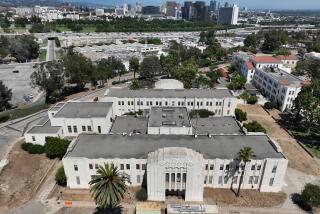Barlow Hospital’s overreach
- Share via
The leafy and historic neighborhoods just north of downtown Los Angeles feature bungalows perched on steep hillsides, businesses huddled on commercial streets and an iconic baseball stadium. But all are dominated by Elysian Park, the 600-acre expanse that makes up the city’s oldest and second-largest park and serves as a backyard for many neighborhoods around it.
And near the edge of that park sits the venerable Barlow Respiratory Hospital, a clutch of historic cottages and buildings on a pastoral 25 acres. It opened more than a century ago as a tuberculosis sanitarium and now functions as a highly regarded long-term care facility for people suffering from severe respiratory illnesses. Structurally outdated and unable to meet orders to seismically retrofit, the hospital, administrators say, must be torn down and rebuilt.
To finance a new facility near the site of the old one, the hospital wants to sell 19 acres of its land to a developer to create a high-density residential development of about 600 units. And to make that happen, administrators have said they will seek massive changes in the zoning and land-use designations of the property. Getting those city approvals, which will allow the hospital to sell the land at a high price, is the only thing that stands between life and death for the hospital, its chief executive, Margaret Crane, contends. If the hospital can’t raise what it needs from a sale, she says, it will go out of business.
As regrettable as it would be if Barlow were to close, that possibility does not justify an upheaval of the zoning and land-use plans for the Silver Lake, Echo Park and Elysian Valley area — the community plan for which was updated nine years ago.
Land-use plans and regulations are adopted after years of meetings and discussion among residents, planners and other experts about how neighborhoods should look and function, about how densely they should be developed and about how much traffic they should bear. The current community plan seems appropriate for this area for the near future. Zoning laws must be updated as the city evolves, and neighborhoods can’t be frozen in time, but that doesn’t mean that one land user should be able to upend its community’s look, feel and function for its own financial purpose, however laudable that purpose may be.
When a significant zoning change is made, it should be for a compelling reason that serves an important community interest. Certainly, ensuring public health falls within that description, and therefore this is not a request to be rejected out of hand. Barlow is known for taking on tough cases and weaning patients off ventilators. That type of care is not plentiful in Los Angeles.
But it’s not impossible to find in the area either. The hospital is relatively small, with 49 beds. (The new facility would have 56.) Although it is an unusual and specialized healthcare facility, it is not a multiservice hospital that serves as a lifeline to a chunk of the city. Health experts suggest that if Barlow were to close, it would cause inconvenience — requiring patients to travel farther to find an appropriate hospital bed — but not a public health crisis.
City planners looking at only a draft environmental report of Barlow’s initial proposal for an 888-unit development noted last year that the increased density and scale were not consistent with the standards for that area. Since then, Barlow has scaled down its proposal to 600 units. And the hospital’s chief executive points out that this development would in no way encroach on the actual territory of Elysian Park.
That’s true, but it’s not the issue. The community plan calls for the site to be used as open space. It is zoned agricultural. That means a community center, a golf course, a park or the least dense kind of housing — a single house per 21/2-acre lot — could be built there.
It would be ideal if Barlow could find a way to either build a new hospital on its property or to operate elsewhere. But the city shouldn’t change the character of the neighborhood for that to happen.
More to Read
A cure for the common opinion
Get thought-provoking perspectives with our weekly newsletter.
You may occasionally receive promotional content from the Los Angeles Times.






